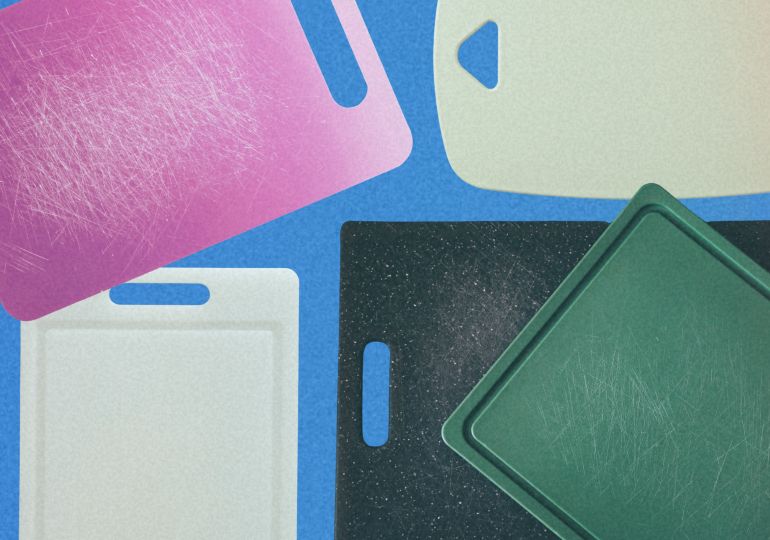Long ago, humans chopped and ground meats and vegetables on natural surfaces like rocks. Eventually, we decided to trade these slab stones for wooden cutting boards. More recently, many home chefs, restaurants, and food producers have switched to plastic boards for convenience, lighter weight, and cost-effectiveness.
But recent research points to a potential downside: the cutting action of knives causes plastic boards to release tiny pieces, called microplastics, into the chopped-up food. Whether these fragments of plastic affect health likely depends on many factors that continue to be studied.
[time-brightcove not-tgx=”true”]
Here’s what researchers say about plastic boards and whether you should replace them with another material.
What happens to the plastic in your cutting board?
Emerging research suggests that when people consume microplastics from various sources, such as plastic water bottles, they could get absorbed by the body’s tissues. Some scientists think such absorption may lead to chronic inflammation and oxidative stress, issues that increase the risk of health problems.
However, some microplastics, including ones from plastic cutting boards, might be too large for our bodies to absorb.
Studies demonstrate that when we cut upon plastic boards, microplastics are produced and mix into the food. A single knife stroke can release 100-300 microplastics, according to one analysis. Research has shown that about 50% of the released microplastics stay on the cutting board after chopping and go down the drain when the board is washed (good for you, perhaps, but not great for wastewater pollution). The other 50%, we consume.
In 2023, a team of scientists at North Dakota State University found microplastics were released into carrots after being chopped on plastic boards. Based on their lab work, the team projected significant exposure to microplastics from regular use of plastic boards for a year. But they looked only for relatively large microplastics, says Syeed Iskander, assistant professor of environmental engineering and the study’s corresponding author.
Read More: What Happens to the Plastic in Dishwasher Pods?
According to some research, only the tiniest microplastics could enter liver cells and cause changes in human colon cells. Other papers have speculated more generally that only microplastics smaller than 10 microns can be taken up by the body’s organs. (A micron is one-thousandth of a millimeter.) Larger pieces might pass through the digestive tract harmlessly.
Iskander thinks that, had his team’s methods allowed them to observe smaller microplastics, they probably would have found many. In another study, researchers in the United Arab Emirates looked at microplastic contamination of raw cut fish and chicken on plastic cutting boards used by butchers. They found only particles 15.6 microns and bigger (though butchers’ forceful chopping may produce different microplastic sizes than home prep).
“The size distribution is important when it comes to health because that really governs whether this material is just going to pass through the body or will permeate it,” says Stephanie Wright, associate professor at Imperial College London who studies microplastics and health. Wright adds the microplastics found in the North Dakota and UAE studies “would typically be considered too large to cross the gut” into the rest of the body.
The UAE study also found that washing the food after it had been chopped—for one minute with running tap water—removed small amounts of microplastics, but the vast majority stuck to the food, says Thies Thiemann, the study’s corresponding author, a chemistry professor at United Arab Emirates University.
Research on particle size isn’t settled. According to some studies, larger microplastics can move through the body’s barriers.
Microplastics may pose a risk regardless of size
Size may be just one determinant of whether microplastics from cutting boards affect health. Some scientists say the chemicals from microplastics could still cause problems, even if the microplastics themselves pass through and out of the body.
Heat is being studied as a factor. After chopped food is mixed with microplastics, it often goes to the oven, stove, or microwave. Because microplastics contain many chemical additives and have a low melting point, “they may break down and release these chemicals, especially if cooked at high temperatures,” Iskander explains. “The chemicals can readily end up in our blood.”
During frying or pressure cooking, “heat will certainly encourage migration of chemical additives out of the plastic,” Wright says. She adds that cooking oils and fatty meats further promote this migration.
Read More: What Happens to the Plastic in Single-Serve Coffee Pods?
The same issue happens in reverse when food is cooked whole and then chopped and scraped while still steaming on plastic boards—a common practice at restaurants, Iskander notes.
Research hasn’t directly connected the use of plastic cutting boards to human health impacts, but it has been explored in animals. This year, scientists in China fed mice diets prepared on boards made of different plastic types. Another group ate food made on wood boards. After a few months of this, the wood-board group was doing fine, but the mice with food cut on plastic boards had more intestinal inflammation and disturbed gut bacteria.
This held true even though no microplastics were found in the mouse bodies, suggesting the chemicals released by the microplastics may have been responsible.
The authors emphasized their findings don’t directly apply to humans. They also noted the mice were purposely given high doses of microplastics to simulate one year of exposure, but over a relatively short period of time. In the future, lower doses should be studied. “It’s hard to extrapolate animal research to much lower exposures every day,” says Wright, who did not work on the study.
In our kitchens, exposure levels can vary based on additional factors, such as how vigorously you chop—firmer food demands more forceful knife strokes—and your frequency of chopping. (Buying pre-made, ultra-processed food to avoid chopping isn’t the answer; studies consistently find ultra-processed foods contain the most microplastics.)
Another issue is how long you’ve had your board. The UAE researchers found plastic boards released more microplastics as they wore down with increased usage. “Repeat behaviors and repeat exposures are probably quite important when we think about long-term health outcomes,” Wright says.
Plastics and chemical additives used in cutting boards sold in the U.S. must meet safety requirements of the U.S. Food and Drug Administration (FDA) for “reasonable certainty of no harm,” says Kimberly Wise White, vice president of regulatory and scientific affairs at the American Chemistry Council, a trade association. “This means the [plastic] polymer used to make the board must comply, as well as any additives,” White says.
The U.S. Department of Agriculture (USDA) advises on its website that plastic cutting boards can be used “without the worry of impacting one’s health.”
But research on microplastics is nascent. The World Health Organization is prioritizing the need to address their “known and predicted health risks.” The European Food Safety Authority says more research is needed, partly because many studies are thought to have overestimated microplastic amounts through flawed measurement. “There’s a lot of uncertainty,” Iskander says.
Cutting board alternatives
If you want to move on from plastic boards, one alternative is wood. However, switching to wood cuts both ways. It involves its own issues and concerns.
Wood is easier on knives than another cutting-board material, titanium, but a potential problem is microbial growth. Wood boards have surfaces with pores that take in moisture and bits of food, letting bacteria penetrate and hang out, potentially leading to cross-contamination.
Ben Chapman, department head of agricultural and health sciences at North Carolina State University—whose podcast Risky or Not? analyzes everyday risks from germs— thinks the risk is low if boards are cleaned after every use. Any leftover bacteria “will probably die as they get trapped deep in the cracks,” he says.
Without such washing, you could become one of 48 million cases of food-borne illness annually in the U.S. If you haven’t gotten sick yet, that doesn’t prove invincibility. “The risk of acute illness is a probability game,” Chapman says, depending on the exposure type and timing.
Read More: 10 Ways to Gracefully Change the Subject
Plastic beats wood on convenience, especially when it comes to cleanliness. The dishwasher would destroy wood boards, whereas plastic is dishwasher-friendly. Wood must be washed by hand: first with soap to remove debris, followed by a food-safe sanitizer, Chapman recommends. He uses a plastic board for raw meats and wood boards for everything else.
As with plastic, wood boards have to be replaced every few years, when they start falling apart or form dark lines as bacteria accumulate, Chapman says. Increase their longevity by sanding down the biofilm lurking on the surface. Chapman sands his board occasionally to remove this top layer of funk.
Wood boards shed microparticles of wood during cutting. However, Chapman notes wood is “essentially plant-based,” so our digestive systems should have no trouble handling these tiny bits.
Another potential problem: most cutting boards are glued together from many pieces of wood. Some glues may leach toxic compounds over time. As with plastic boards, though, these additives must be FDA-approved for food contact.
Other (more expensive) versions are made of a single solid piece of wood, Thiemann says. No microplastics, glues, or mixed wood materials could mean fewer mixed feelings about your cutting board.
Leave a comment



